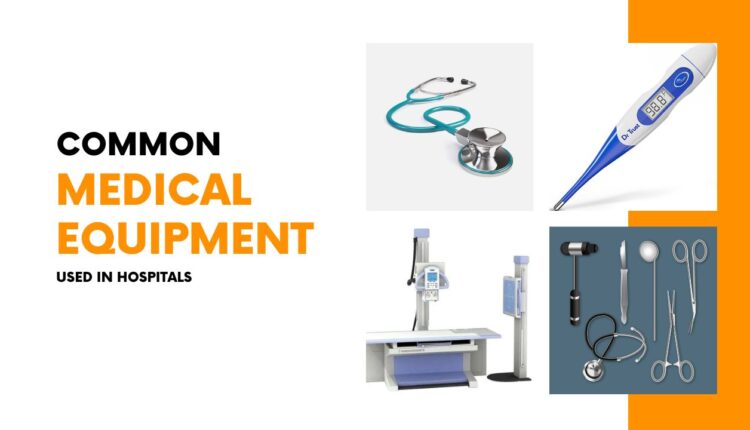Table of Contents
Medical facilities are outfitted with essential medical devices for diagnosing and treating patients. The purpose of this medical equipment is to assist medical professionals in making accurate diagnoses, monitoring patients, and administering the appropriate treatment. Hospitals rely on vast equipment to provide optimal care, from virtual devices to complex machinery. This blog will examine the standard medical equipment used in hospitals and its importance in healthcare settings.
The Medical Equipment List Is the Foundation of Hospital Care
Hospitals are outfitted with a comprehensive list of medical devices to accommodate a variety of medical specialties and patient requirements. These devices serve various functions, from simple diagnostic instruments to sophisticated life support systems. Here is an overview of some of the most common hospital medical equipment:
1. Stethoscope:
Physicians and nurses use this instrument to listen to a patient’s heart, lungs, and other internal sounds. It aids in detecting abnormalities such as cardiac murmurs and lung congestion, thereby facilitating the initial evaluation of a patient’s condition.
2. Blood Pressure Machine:
This device measures a patient’s blood pressure and provides vital information about their cardiovascular health. It consists of an arm-wrapped inflatable cuff and a pressure gauge or digital display for reading the results.
3. Thermometer:
Temperature measurement is a fundamental component of patient evaluation. Whether digital or infrared, thermometers are utilised to detect fever and hypothermia, thereby guiding treatment decisions.
4. Electrocardiogram (ECG):
An ECG machine captures the heart’s electrical activity, assisting physicians in diagnosing various cardiac conditions, such as irregular heart rhythms and heart attacks. It entails attaching electrodes to the patient’s chest and transmitting electrical signals from the heart to the machine.
5. X-ray machine:
X-ray imaging is a prevalent diagnostic technique used to visualise the internal structures of the human body. X-ray devices generate images that help detect fractures, tumours, lung conditions, and other abnormalities.
6. Ultrasound Machine:
Ultrasound devices create images of internal organs and tissues using high-frequency sound radiation. These non-invasive examinations are frequently employed in obstetrics and gynaecology, cardiology, and general radiology.
7. Surgical Tools:
Surgical instruments include various devices used during surgical procedures, including scalpels, forceps, retractors, and suturing materials. These instruments allow surgeons to make incisions, manipulations, and repairs with precision and control.
8. Ventilators:
Ventilators, also known as respirators, are devices used to aid patients with breathing difficulties or respiratory failure. These devices deliver regulated quantities of oxygen and aid in removing carbon dioxide from the airways.
9. Defibrillator:
In cardiac arrest or life-threatening arrhythmias, defibrillators administer an electric charge to a patient’s heart. They can be located in various hospital areas, including emergency rooms and intensive care units, and restore the heart’s normal rhythm.
10. Infusion Pump:
Infusion devices are utilised to administer fluids, medications, or nutrients directly into a patient’s bloodstream in a controlled and accurate manner. These devices are frequently employed in intravenous therapy, chemotherapy, and intensive care contexts.
11. Anesthesia Machine:
Anaesthesia devices are necessary for surgical procedures to administer anaesthetic gases or intravenous drugs to relieve unconsciousness and relieve pain.
12. MRI Machines:
Magnetic Resonance Imaging (MRI) devices use powerful magnets and radio waves to create detailed images of the body’s internal structures. They are handy for diagnosing injuries to soft tissue, brain abnormalities, and certain types of malignancy.
Hospital Equipment List for Patient Care Quality
These were the basic medical equipment list that represents only a portion of the devices found in hospitals around the globe. Each medical device is essential for making accurate diagnoses, administering effective treatment, and ensuring patient safety. In addition, hospitals are constantly updating their apparatus to incorporate technological advancements and enhance patient outcomes. Let us take you to a run down for an ICU equipment list:
- Mechanical Ventilator: A mechanical ventilator is a critical equipment used to support patients who cannot breathe adequately. It delivers a controlled mix of oxygen and air, assisting with respiration.
- Hemodynamic Monitoring System: This equipment monitors a patient’s cardiovascular system by measuring various parameters such as blood pressure, heart rate, central venous pressure, and cardiac output. It helps assess cardiac function and fluid status.
- Patient Monitor: A patient monitor displays and tracks vital signs, including heart rate, blood pressure, respiratory rate, oxygen saturation, and temperature. It provides continuous monitoring and alerts healthcare providers to any changes or abnormalities.
- Dialysis Machine: In the ICU, a dialysis machine may be used for patients with acute kidney injury or end-stage renal disease. It filters the blood, removes waste products and excess fluid, and helps maintain electrolyte and fluid balance.
- Intravenous Infusion Pump: IV infusion pumps are used to deliver medications, fluids, and nutrients directly into a patient’s bloodstream. They ensure precise and controlled administration, allowing for accurate dosing and continuous therapy.
These are a critical list of medical devices, but it’s important to note that ICU settings can vary, and additional specialised equipment may be required depending on the patient’s specific needs.
The proper operation and maintenance of medical devices are indispensable to their efficacy. Regular calibration, maintenance, and adherence to safety protocols are essential to ensure accurate readings and dependable performance. Healthcare professionals receive specialised training to operate and interpret these instruments effectively.
In conclusion, hospital care relies heavily on medical apparatus. Each diagnostic, therapeutic, and monitoring device serves a distinct purpose, from the simple stethoscope to the complex MRI machine. Hospitals invest in a diverse array of equipment to meet the requirements of various medical specialities and patient conditions. Continuous advances in medical technology continue to improve the standard of care provided in healthcare settings. By effectively utilising these medical devices, healthcare professionals can make informed decisions and provide optimal patient treatment.
See Also:



